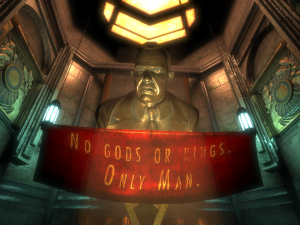Bioshock: Photography
Just a short session last night, and with little progress to show for it. So let’s talk about the next significant mechanic the game brings forth. (It dribbles them out one by one.) At a certain point in the third level, you obtain a “research camera”. Progress in the plot is in fact contingent on finding it, so the designers clearly felt that finding it at that stage was important.
Despite not being capable of doing damage, the camera occupies a weapon slot. It treats film as a kind of ammo — one of the few types I’m not maxed out on at the moment. This is because you pretty much want to take a picture of every single enemy in the game, as well as certain machines. Doing so gives you research points toward the thing depicted, which are sort of like experience points: they fill up a progress meter until you “level up” and gain some benefit, with increasing numbers of points required for each level. The peculiar thing is, the research points are specific to the thing photographed. You’re leveling up for each monster type in parallel. So, although the camera is reminiscent of Pokemon Snap and, more particularly, Beyond Good and Evil (with which it shares the challenge of trying to photograph things while they’re attacking you), it also feels a bit like the way you level up specific Jobs with “Ability Points” in Final Fantasy V. This is just one way that the game is at least as much CRPG as FPS.
The number of points you get for taking a picture depends on its quality, which is evaluated and assigned a letter grade in a special picture-grading screen while the action in the world hangs frozen. (If your first picture of a subject is good enough, it can be enough to get you to the next research level all by itself.) Picture quality mainly seems to be determined by how close you are to the subject and how centered it is. The evaluation will often indicate bonus attributes, such as “Action shot” and “Multiple subjects”, although it’s not clear to me if these are things that affect the letter grade or additional modifiers on top of it. “Multiple subjects” is an interesting one, because, in a limited way, it lets you get credit for photographing the same subject more than once, which is otherwise impossible — attempts at taking multiple pictures of the same thing don’t even consume film, an unrealistic touch but a gentle one. There are occasions when the “multiple subject” tag has taken me completely by surprise, because I thought the thing I was photographic was alone. Sometimes it was; sometimes the other subjects were already dead. And yes, corpses can be photographed, but they give only a fraction of the points that a live subject does. The designers really wanted to make sure that the photography that’s rewarded is the risky kind. Even the “action shot” bonus seems to mean taking a picture of something at the moment it makes an attack.
And what do you get for your research? The most common benefit seems to be a combat bonus against the subject’s type, which is probably worth having, but kind of boring. If that were all you got, I’d probably still try to photograph stuff, but only in the way that I go for items that give a score bonus in an arcade-type game: as a little extra challenge that I don’t think about very much and pass by if it looks too difficult. But certain subject types, at certain levels, give you other things, such as gene tonics (passive buffs). You have a limited number of slots for gene tonics, but having more types means having more options. This is enough to trigger the “gotta catch ’em all” response in me, and for a while now, I’ve basically let no enemy go unresearched.
 Comments(0)
Comments(0)